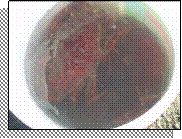|
Dead crab is bad crab |

|
Eating crab that has died prior to cooking can be extremely bad for you as a result of bacterial growth (Maryland† Seafood & Aquaculture). If you live more than a few minutes from your favorite crabbing location, or will be crabbing for an extended period of time, check out this tip on keeping your tender morsels safe to eat:
|
|
Live far from the pier? Keep your crabs alive all the way home! |
|
Date: 11/23/2010 |


|
The ice chest crab carrier
The most important thing to know about keeping crabs alive is that they need oxygen and suffer in dirty water. The pics to the right show how quickly a standard bucket can become cloudy with the crabsí own filth. These pictures were taken maybe half hour to an hour apart. We discovered that crabs actually donít need to be immersed in water to live, which is a good thing since they foul water very quickly! Keep your crabs in a clean bucket of water while youíre on the dock, then transfer to the crab carrier after a couple hours, or when youíre ready to leave. To make our live crab carrier you need: ††††††††† * Ice chest Fill the plastic bottles approximately 3/4 full with water (to allow for expansion) and freeze. Lay the bottles in the bottom of the ice chestóyou donít need a fully covered bottom, but do need sufficient bottles to keep the chest cool. Take the dry bath towel and place over the bottles in such a way that the crabs canít touch them directly. This provides a cool, but not frozen surface for the crabs to be on. If the crabs are laid directly on ice, they can freeze to death. Once you begin loading your crabs into the ice chest, wet and crumple up some newspaper to lay and loosely pack around the crabs. Donít pack tightly! The newspaper will also act as a tactile shield to stop them from fighting. Itís very important to leave the ice chest open a crack for air. We usually use the corner of the towel to keep the lid open about an inch. We have begun crabbing at 8 or 9 in the morning and kept our first catches alive until 8 or 9pm when we finally returned home. After you take them out of the ice chest, they will warm up and start moving or walking around. If they donít moveódonít eat them! |




|
© 2010 MediaLogistix - webmaster@medialogistix.us |